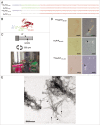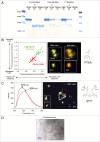Amyloid fibrils of human prion protein are spun and woven from morphologically disordered aggregates
- PMID: 19923901
- PMCID: PMC2807696
- DOI: 10.4161/pri.3.4.10112
Amyloid fibrils of human prion protein are spun and woven from morphologically disordered aggregates
Abstract
Propagation and infectivity of prions in human prionopathies are likely associated with conversion of the mainly alpha-helical human prion protein, HuPrP, into an aggregated form with amyloid-like properties. Previous reports on efficient conversion of recombinant HuPrP have used mild to harsh denaturing conditions to generate amyloid fibrils in vitro. Herein we report on the in vitro conversion of four forms of truncated HuPrP (sequences 90-231 and 121-231 with and without an N-terminal hexa histidine tag) into amyloid-like fibrils within a few hours by using a protocol (phosphate buffered saline solutions at neutral pH with intense agitation) close to physiological conditions. The conversion process monitored by thioflavin T, ThT, revealed a three stage process with lag, growth and equilibrium phases. Seeding with preformed fibrils shortened the lag phase demonstrating the classic nucleated polymerization mechanism for the reaction. Interestingly, comparing thioflavin T kinetics with solubility and turbidity kinetics it was found that the protein initially formed nonthioflavionophilic, morphologically disordered aggregates that over time matured into amyloid fibrils. By transmission electron microscopy and by fluorescence microscopy of aggregates stained with luminescent conjugated polythiophenes (LCPs); we demonstrated that HuPrP undergoes a conformational conversion where spun and woven fibrils protruded from morphologically disordered aggregates. The initial aggregation functioned as a kinetic trap that decelerated nucleation into a fibrillation competent nucleus, but at the same time without aggregation there was no onset of amyloid fibril formation. The agitation, which was necessary for fibril formation to be induced, transiently exposes the protein to the air-water interface suggests a hitherto largely unexplored denaturing environment for prion conversion.
Figures




Similar articles
-
Dissection of conformational conversion events during prion amyloid fibril formation using hydrogen exchange and mass spectrometry.J Mol Biol. 2013 Sep 23;425(18):3510-21. doi: 10.1016/j.jmb.2013.06.009. Epub 2013 Jun 25. J Mol Biol. 2013. PMID: 23811055
-
Development of the structural core and of conformational heterogeneity during the conversion of oligomers of the mouse prion protein to worm-like amyloid fibrils.J Mol Biol. 2012 Oct 19;423(2):217-31. doi: 10.1016/j.jmb.2012.06.040. Epub 2012 Jul 9. J Mol Biol. 2012. PMID: 22789566
-
Amyloid nucleation and hierarchical assembly of Ure2p fibrils. Role of asparagine/glutamine repeat and nonrepeat regions of the prion domains.J Biol Chem. 2004 Jan 30;279(5):3361-9. doi: 10.1074/jbc.M310494200. Epub 2003 Nov 10. J Biol Chem. 2004. PMID: 14610069
-
Life cycle of yeast prions: propagation mediated by amyloid fibrils.Protein Pept Lett. 2009;16(3):271-6. doi: 10.2174/092986609787601796. Protein Pept Lett. 2009. PMID: 19275740 Review.
-
Amyloids, prions and the inherent infectious nature of misfolded protein aggregates.Trends Biochem Sci. 2006 Mar;31(3):150-5. doi: 10.1016/j.tibs.2006.01.002. Epub 2006 Feb 13. Trends Biochem Sci. 2006. PMID: 16473510 Review.
Cited by
-
Polythiophenes inhibit prion propagation by stabilizing prion protein (PrP) aggregates.J Biol Chem. 2012 Jun 1;287(23):18872-87. doi: 10.1074/jbc.M112.355958. Epub 2012 Apr 6. J Biol Chem. 2012. PMID: 22493452 Free PMC article.
-
Protein Structure and Biology: Poster Abstracts.Prion. 2013 Apr/May;7(sup1):81-104. doi: 10.4161/pri.24866. Prion. 2013. PMID: 29095079 Free PMC article. No abstract available.
-
Two amyloid States of the prion protein display significantly different folding patterns.J Mol Biol. 2010 Jul 23;400(4):908-21. doi: 10.1016/j.jmb.2010.05.051. Epub 2010 May 27. J Mol Biol. 2010. PMID: 20553730 Free PMC article.
-
Purification and Fibrillation of Full-Length Recombinant PrP.Methods Mol Biol. 2017;1658:3-22. doi: 10.1007/978-1-4939-7244-9_1. Methods Mol Biol. 2017. PMID: 28861778 Free PMC article.
-
Allosteric function and dysfunction of the prion protein.Cell Mol Life Sci. 2012 Apr;69(7):1105-24. doi: 10.1007/s00018-011-0847-7. Epub 2011 Oct 9. Cell Mol Life Sci. 2012. PMID: 21984610 Free PMC article. Review.
References
-
- Westermark P. Aspects on human amyloid forms and their fibril polypeptides. The FEBS journal. 2005;272:5942–5949. - PubMed
-
- Chiti F, Dobson CM. Protein misfolding, functional amyloid and human disease. Ann Rev Biochem. 2006;75:333–366. - PubMed
-
- Mishra R, Sorgjerd K, Nystrom S, Nordigarden A, Yu YC, Hammarstrom P. Lysozyme amyloidogenesis is accelerated by specific nicking and fragmentation but decelerated by intact protein binding and conversion. J Mol Biol. 2007;366:1029–1044. - PubMed
-
- Liberski PP. Amyloid plaques in transmissible spongiform encephalopathies (prion diseases) Folia neuropathologica. 2004;42:109–119. - PubMed
-
- Prusiner SB. Novel proteinaceous infectious particles cause scrapie. Science. 1982;216:136–144. - PubMed
Publication types
MeSH terms
Substances
LinkOut - more resources
Full Text Sources
